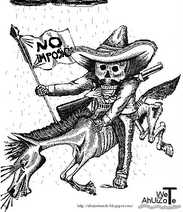Esta es una nota a nivel de telegrama que sale en el New York Times. En mi opinion la situacion en Estados Unidos como en Inglaterra en lo que ellos llaman su lucha contra el terrorism no les permite ver mas alla de Irak y Afganistan. Latinoamerica no es un tema relevante aunque de vez en cuando dar covertura. .... This is a telegraphic note at the New York Times. In my humble opinion situation in the States and England in what they call the war on terrorism does not allow them to look beyond. Latin America situation is not a relevant topic despite de fact that every now and then exist coverage for it.
Este artículo describe vagamente lo que sucede,… no menciona por ejemplo lo de los balazos ni la marcha de la asamblea popular de pueblos de Oaxaca a la ciudad de México. Y sin embargo la periodista no tiene ningún problema in reproducir el que se le atribuye a la APPO el asesinato del maestro Calva. El reportero es REBECA ROMERO, de Associated Press Writer. ...This report vaguely describes what is happening in Oaxaca,… it does not mention for example anything about the shootouts neither the it does about the walk towards Mexico. However, the journalist does not have any problem in reproducing that APPO members assassinated teacher Calva. The journalist is REBECA ROMERO, from Associated Press Writer.
-------------------------
Mexican Teachers Refuse to End Strike
By THE ASSOCIATED PRESS
Published: October 8, 2006
Filed at 2:05 a.m. ET
OAXACA, Mexico (AP) -- Striking teachers Saturday rejected a federal government offer aimed at ending a nearly five-month strike and protests that have paralyzed much of the colonial Mexican city of Oaxaca.
The teachers said they would insist on their principal demand, the resignation of Oaxaca Gov. Ulises Ruiz. Federal officials have said only the Senate can remove a governor.
The rejection of the government proposal is likely to increase tensions in Oaxaca, where leftist protesters have joined striking teachers in erecting barricades, running off police, scaring away tourists and seizing radio and television stations.
Details of the offer have not been made public, but reportedly included the wage increases that originally motivated the strike.
The teachers also demanded that thousands of army and navy personnel posted in Oaxaca leave. The protesters claim the troops are preparing to forcibly retake the city's center.
In announcing the rejection, union leader Enrique Rueda Pacheco said ''we have decided to open ourselves to negotiation, but that does not mean we're taking off the table our demand that Mr. Ulises Ruiz resign.''
On Saturday, relatives buried a teacher who had been stabbed two days earlier by assailants with an ice pick. The victim, Jaime Rene Calva Aragon, 53, belonged to a group that opposed the strike, and other dissident teachers have accused militant leftists of being behind the killing.
Calva Aragon had apparently angered strike supporters by teaching students at his home during the work stoppage.
''It's not right because he was a good man,'' Calva Aragon's sister, Marilu, told reporters Saturday.
The violence raised fears that the strikers' intransigence could lead to a wider confrontation. Oaxaca businessmen and others who have lost millions of dollars during the protests have pressed the federal government to restore order.
The protesters detained three police officers on the city's outskirts Friday before releasing them.
Thousands of state police have gathered outside the city in recent days, and helicopters and military planes have flown over the demonstrators.
The teachers also rejected a government invitation for a meeting Sunday in Oaxaca; the main talks have been held in Mexico City. Strike leaders said the government also asked that they return to classes and allow federal police to patrol the city, but the teachers said they would only consider those requests after their demand for the governor's resignation is resolved.
The protesters claim Ruiz won his post in a rigged election and used violence against them in a previous attempt to break up protest camps in the city's picturesque, arch-ringed main plaza.
Both the U.S. and British embassies in Mexico have warned their citizens about visiting Oaxaca, which is normally popular for its colonial architecture and ancient pyramids.
skip to main |
skip to sidebar

this is a dedicated space for commenting about Mexican politics, and other issues,....
WeT_AhUiZoTeTV
AhuizoTwitter
Visits since November 28 2006
WeT_AhUiZoTe

e-mail:
Blog Archive
My Links
- Oaxaca Revolt, Site with updates from the ground
- Brad Will last Video (English subtittles) part I
- Brad Will Last Video (English Subtittle) Part II
- Brad Will Last Video
- NO FEDERAL POLICE DEMAND!!!!
- Direct Link to Radio Universidad UABJO (APPO Media in spanish)
- Listado de Blogs
- Topix, News on Oaxaca
- Popular Assambly of the People of Oaxaca (APPO)
- RaDiOaMlO, THE BEST alternative media
- Radio vulgocracia, an alternative view of Mexcio
- el sendero del PG
- Google News
- Periodistas y Medios Alternativos en USA
- Sin sosten,... My other favorite 'short'
- My favourite short,... hasta los huesos 'till the bones'
- Blog 'Solo Convocatorias' puts everithing civil resistence in Mexico is doing in one site
- Alive in Mexico Project